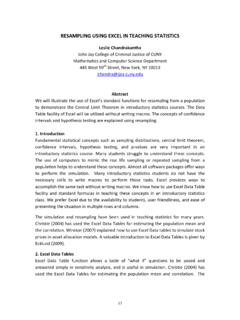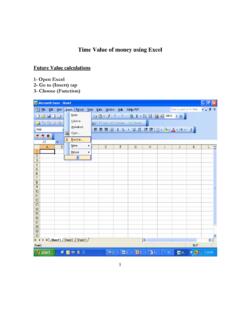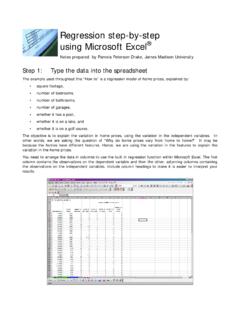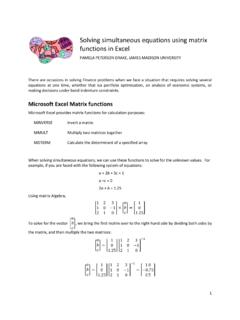Transcription of How to Use Excel for Data Entry - University of California ...
1 How to Use Excel for data Entry The Statistical Consulting Center Excel is a very popular tool for entering and manipulating data . This document shows you how to enter data that you can easily open in statistics packages such as SPSS or SAS. Excel has some statistical analysis capabilities but they have severe limitations and we do not recommend using them. For a comprehensive list of these limitations, see Using Excel for Statistics, Tips and Warnings at . We support many options for automated data Entry ; including darken-the-circle scan forms, web surveys and data acquisition directly from scientific instruments.
2 If you have questions regarding data input or analysis, contact the Statistical Consulting Center via the Helpdesk at 865-974-9900. We will do our best to get back to you within 24 hours. Most UT Knoxville students, faculty and staff may receive up to 10 free hours of statistical computing assistance each semester. See for details. We also offer training in SPSS each semester. See ~training for details. Basic Rules of data Structure All your data should be in a single spreadsheet of a single file.
3 Enter variable names in the first row of the spreadsheet. Use variable names that are no longer than 8 characters, beginning with a letter. Variable names cannot contain spaces, but may use the underscore character. No other text rows such as titles should be in the spreadsheet. No blank rows should appear in the data . Always include an ID variable on your original data collection form and in the spreadsheet to help you find the case again if you need to correct errors. You may need to sort the data later, so the row number in Excel would then apply to a different subject or sampling unit.
4 If you have multiple groups, put them in the same spreadsheet along with a variable that indicates group membership (see Gender example below). Avoid using alphabetic characters for values. For example to enter political party, enter 1 instead of Democrat, 2 instead of Republican and 3 instead of Other. If your group has only two levels, coding them 0 and 1 makes some analyses much easier to do. For missing values, leave the cell blank. Although SPSS and SAS use a period to represent a missing value, if you actually type a period in Excel , stat packages will read the column as character data so you won t, for example, be able to calculate even the mean of a column.
5 You can enter dates with slashes (6/13/2003) and times with colons (12:15 AM). For text analysis, you can enter up to 32K of text, about 8 pages in a single cell. However, if you cut & paste if from elsewhere, remove carriage returns first so as they will cause it to jump to a new cell. An example of data that's easy to open in statistics packages ID Gender Salary 1 0 32000 2 1 23000 3 0 37000 4 1 54000 5 1 48500 The same data entered in a style that can not be opened in statistics packages.
6 data for Female Subjects ID Salary 132000 337000 data for Male Subjects ID Salary 223000 454000 548500 data Entry Tips Save your data frequently and make backup copies and store them in separate buildings. Don t risk losing all your hard work in a fire or theft! Avoid using Excel to sort your data . It s too easy to sort one column independent of the others, which essentially destroys your data ! Statistics packages can sort data and they understand the importance of keeping all the values in each row locked together.
7 If you need to enter a pattern of consecutive values such as an ID number with values such as 1,2,3 or 1001,1002,1003, enter the first two, select them and drag the box in the lower right corner as far as you wish. Excel will see the pattern of the first two entries and extend it as far as you drag your selection. This works for days of the week and dates too. You can create your own lists in Options>Lists, if you use a certain pattern often. To help prevent typos, you can set minimum and maximum values, or create a list of valid values.
8 Select a column or set of similar columns, then Choose Validation from the data menu. To set minimum and maximum values, choose Allow: Whole Numbers or Decimals and then fill in the values in the Minimum and Maximum boxes. To create a list of valid values, choose Allow: List and then fill in the numeric or character values separated by commas in the Source box. The gold standard for data accuracy is the dual Entry method. With this method you actually enter all the data twice. Only this method can catch errors that are within the normal range, but still wrong.
9 Excel can show you where the values differ. Enter the data first in Sheet1. Then enter it again using the exact same layout in Sheet2. Finally, go to Sheet3 in cell A1 and enter this formula: =IF(sheet1!A1=sheet2!A1,1,0) This means that if the value in Sheet1 cell A1 is equal to the value in Sheet2 cell A1, then Sheet3 A1 will display a 1 to indicate a match and 0 to indicate bad data . To extend this formula to all the cells, select cell A1 in Sheet3 and drag the box in the lower right corner until the cell stretches to cover all the space you used for your data in Sheet1.
10 Then check to see where the zeros are in sheet 3. Those will be your typos. You then check to see which Entry was wrong, Sheet1 or Sheet2. Make corrections until Sheet3 is full of ones, indicating no errors. When you read the data into a statistics package, you will only need to read the data in Sheet1. When looking for data errors, it can be very helpful to display only a subset of values. To do this, select all the columns you wish to scan for errors. Choose Filter from the data menu and then choose Autofilter.









